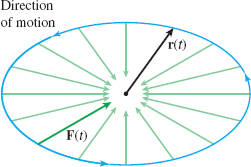EXAMPLE 2Finding the Force Acting on a Particle Moving Along an Ellipse
The position of a particle of mass m that is moving along an ellipse with a constant angular speed ω is given by the vector function r(t)=Acos(ωt)i+Bsin(ωt)j0≤t≤2π
Find the force F acting on the particle at any time t. Graph r=r(t) and F=F(t).

Figure 27 F(t)=−mω2r(t)
Solution To find the force F, we use Newton's Second Law of Motion, F=ma. We begin by finding the acceleration a of the particle. r(t)=Acos(ωt)i+Bsin(ωt)jv(t)=r′(t)=−Aωsin(ωt)i+Bωcos(ωt)ja(t)=r′′(t)=−Aω2cos(ωt)i−Bω2sin(ωt)j=−ω2r(t)
Then, by Newton's Law, F(t)=ma(t)=−m ω2r(t)
The direction of the force vector F is opposite to that of the vector r at any time t, as shown in Figure 27.